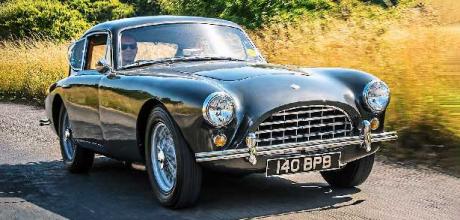1956 AC Aceca
Automotive explorer Chris Dady has raced, restored and toured his way through 70 cars. Will a day driving a 1956 AC Aceca sway his next classic purchase?
Road test 1956 AC Aceca
‘It has beautiful balance, poise and positivity’
Words EMMA WOODCOCK
Photos IAN SKELTON
The List Reader Chris Dady takes the wheel of an AC Aceca — will it join his 70-car haul?
Classic Cars reader Chris Dady wastes no time at all clambering aboard his steed for the day, a 1956 AC Aceca. His rich motoring life has taken him to all corners of the classic realm, owning rarities from an Elva Courier fastback prototype through a Saab Sonnet to an ex-works Riley Ulster Imp, yet he discovered the obscure Thames Ditton coupé just five years ago. ‘I’ve dreamed of driving one ever since. The fastback shape is such a beautiful, unfussy development of the earlier Ace and highly inventive with it. I can’t think of another Fifties sports car that spawned a grand tourer so successfully.’ He turns the ignition key. Today we’re making his wish come true… The 2.0-litre AC inline-six erupts through twin pipes. ‘What a fabulous sound! It’s loud in here – though no more so than I was expecting – and the exhaust note is simply fantastic, even at idle.’ Before we pull away, he pauses to take in his surroundings. ‘I’m struck by the beautiful view down the long bonnet, yet it’s the cabin that makes the Aceca so fit for its intended purpose. There’s plenty of room behind us for luggage and the driving position is just about perfect. The steering wheel is close enough that I feel well in control, with my legs slotting easily around either side. I’d prefer the footwell to stretch an extra couple of inches, yet I’m still comfortable.
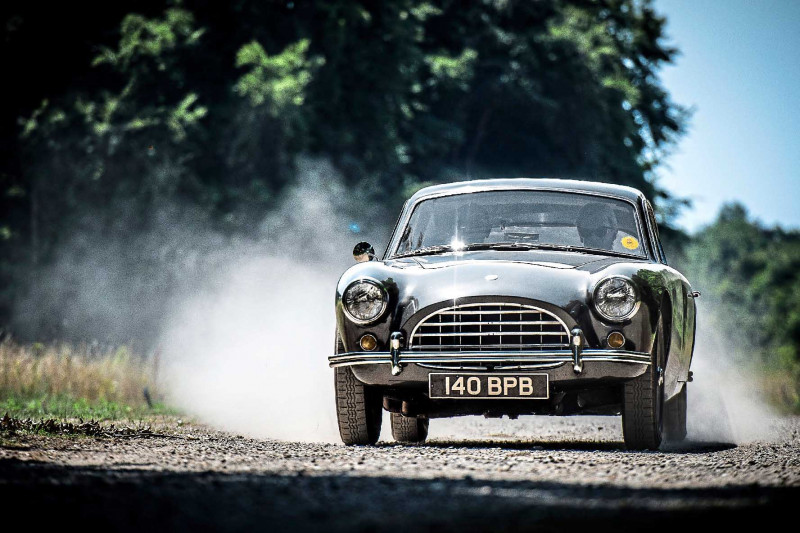
Will the AC Aceca impress reader Chris Dady – who’s owned 70 cars
‘I couldn’t call this a concours example, but I’m excited to be driving such an original Aceca,’ he continues. ‘It’s all the better for its lived-in leather seats and all-round standard drum brakes.’ Richard Hackett of Warminster dealer SLJ Hackett agrees. He’s currently selling the car on behalf of its owner, priced at £89,500. Says Richard, ‘High-lift camshaft aside, it’s a very period-correct example, in need of little more than a good service and an engine tune. We’ve sold two other Acecas in recent years – they’re extremely good-looking cars and delightfully handmade.’ Hunting for first gear, Chris begins measuring his dream machine against reality. His expression darkens as we wind through urban medieval streets, the AC posing challenges from every direction. ‘Coming from the modern automatic Skoda I drove here, the Aceca is confounding! The Moss transmission isn’t the easiest shift and I’m battling to keep the revs high, something made all the more challenging by the racy cam. And – beautiful as the exhaust might sound – I think I’d want earplugs before embarking on any longer journeys!’
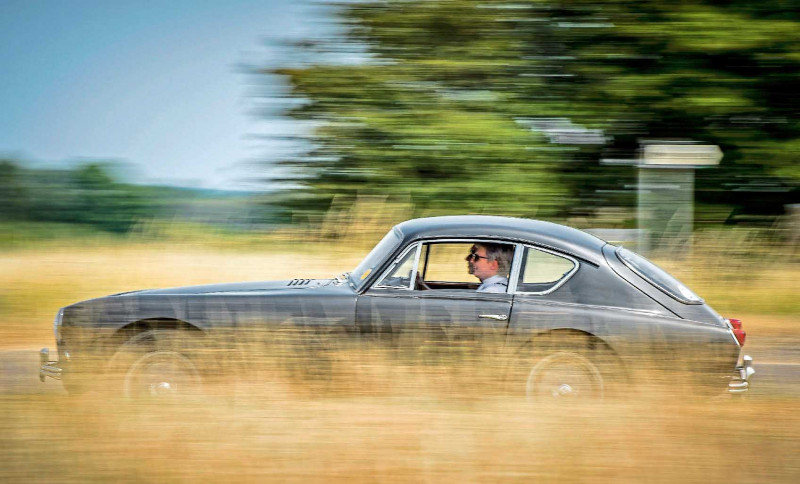
‘I still can’t get off the line smoothly,’ he sighs as we navigate tight urban junctions. ‘The engine really offers nothing around 2000rpm and there’s a substantial gap between first and the incredibly long second gear. That’s before we get to mastering the shift itself. The gearbox can’t be hurried, which feels like the Aceca taking charge. It’ll change gear when it’s ready, not necessarily when I think a shift should take place. I’m lifting the clutch as I pass through the neutral plane, almost double-declutching, to smooth out the process.’
‘The chassis stays nice and level, always composed yet letting me feel the road’
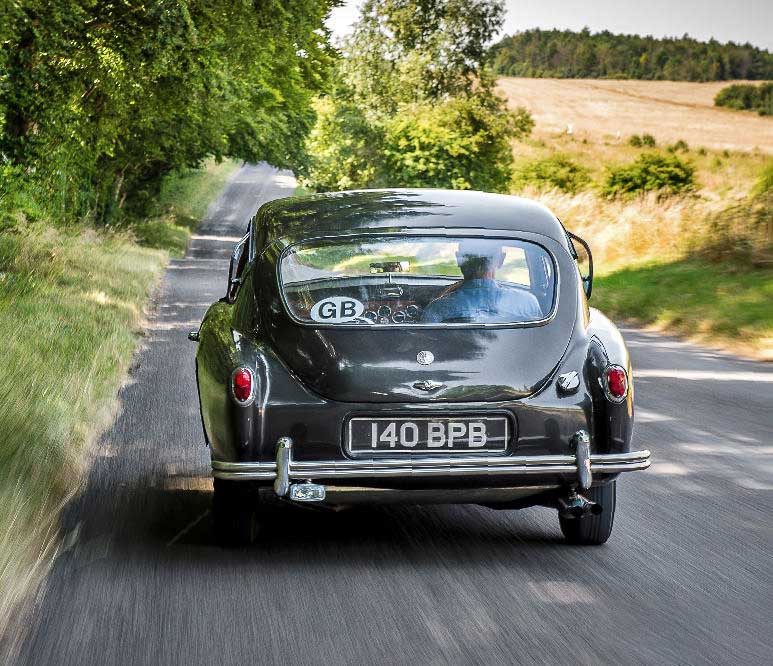
Our route out of town opens into a fast, wide A-road and Chris reaches to his right, thumbing the overdrive in anticipation of a long-limbed cruise. That doesn’t happen. After a blink-length pause, the revs jump and the exhaust shoots to a tight, insistent timbre. ‘Oh – oops! The system must have been engaged when we set off, which explains the gap between ratios. It’s an unlabelled switch, so there’s no visual confirmation either way.’ Taking advantage, he pushes the slim accelerator to the floor. ‘The Light Six engine feels ever more lively as the revs rise, with a pleasing and sporting exhaust note to match. I’m slightly in awe of its history – which stretches way back to 1919, taking rumoured inspiration from the engines of Zeppelin airships downed during World War One – yet it remains smooth and strong when used in the higher reaches of its operating range.
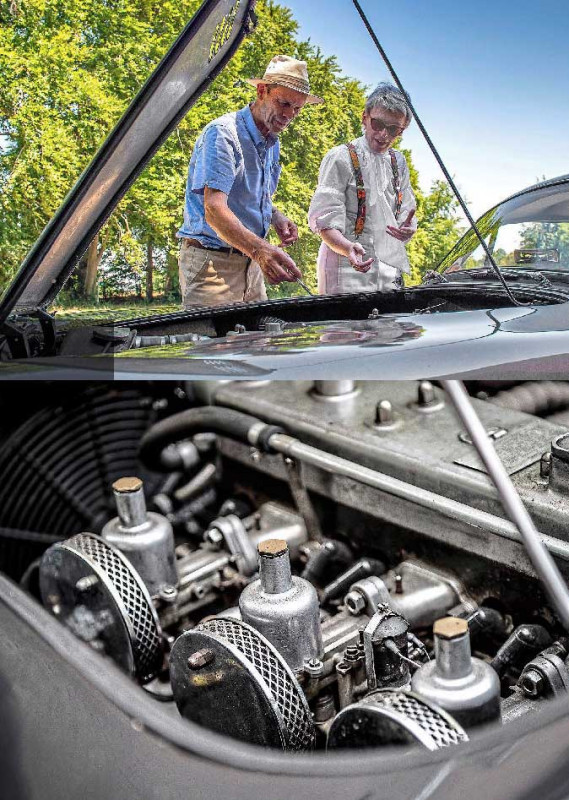
I love its urgency. It never lets me forget that I’m piloting a Fifties sports car, though I’d personally prefer to fit a milder cam. ‘Once we’re underway, the Aceca feels perfectly fast enough. AC offered Bristol and Ford engines alongside its own inline-six, but I’m not missing the extra performance they would provide. I like the AC engine and it suits a road car package – it more than keeps up with modern-day traffic.’ Nonetheless, Chris has to work hard to maintain speed, rowing the gearlever and overdrive as we climb onto Salisbury Plain. ‘I’ve got to be mindful and make sure I’m always in the right gear. The Aceca needs all seven ratios to make smooth progress.
‘All this shifting can’t make for a relaxing cruiser, but it works on this kind of road,’ he continues as we wend towards Chitterne. ‘It’s a car to really be driven. Now I’ve acclimatised, the Aceca has beautiful balance, poise and positivity, with steering to match. Though it wanders slightly at speed – as I’d expect with any older car on skinny tyres – it never needs correcting and I can trust it to track true.’
The tarmac undulates viciously ahead, prompting Chris to think about ride quality. ‘I feared the worse before I got behind the wheel. I’ve been watching Aceca videos online and one road test showed the occupants bouncing around terribly. But it’s nothing like that – I can’t detect any crashiness. The chassis stays nice and level, always composed yet still letting me feel the road through the car. It’s exactly as I’d want.’ Crunching up a gravel track, securing a shaded spot out of the midday sun, he calls a break to examine his dream car’s visual virtues.
‘What a clean and well-proportioned design, and one that works from every angle. The smooth, unadorned bonnet harmonises with the falling line down over the grille, while details like the rear numberplate window just transport me back to its era.’ With its striking tailgate, the distinctive outline soon invites comparison with a contemporary competitor. ‘The Aston Martin DB2/4 shares the same hatchback lines – and there are some similarities between the cars – but I’m surprised by how much more delicate the Aceca looks. I enjoy the purity of its shape, which looks so much nicer than the messed-around Cobra and its engorged wheelarches.
‘It’s a shame that so many people see AC Cars as a one-hit wonder,’ he continues. ‘The Cobra dominates knowledge of the marque and the company has perhaps lost something as a result. It was only when I started researching the firm and its history that I discovered that it’d produced so many interesting models, from the Invacar to the Frua-designed 428 to the midengined 3000ME. And all that before we consider the overhead camshaft Light Six, which has to be one of the longest-serving engines ever designed. It looks so clean and simple, especially in the uncrowded Aceca engine bay. I love the link it creates with a distant past.
‘There’s nothing not to like inside,’ he continues from his reassumed position in the cabin. ‘Visibility is good in all directions and I’m finding it easy to climb in and out. All the instruments are easy to see, even those in the centre of the dash, though the convex faces covering the fuel and oil gauges can make those readouts more difficult to read. I love the AC-branded pedals, which fit my size 91/2 feet perfectly and exude wonderful authenticity from their worn contact points, but I have to pick the driving seat as my favourite interior feature. It’s just wonderful, holding me snugly within its structure.’
A quartet of tight corners prove just how much the bucketstyle chairs add to back-road enjoyment. Wedged firmly in place, Chris can start probing the car’s cornering abilities with confidence. ‘I’m sitting deep down into the cushion, with good lateral support from the backrest to match. It’s a marked contrast to the XKs I’ve owned in the past – they have entirely flat seats, and I’d be falling all over the place on a road like this! Not so the Aceca. I’m well held in place, which is just as well with no seatbelts!
‘I can sense the car around me and nothing feels remote. I’m trying to get everything done before each corner, making downshifts in good time to account for the slow gearchange, then carrying momentum through the bend. The brakes might be drums, but they’re responsive and inspire confidence, plus the steering lightens at speed and feels good as I turn in. The Aceca shows balance and poise but has to be driven through each corner or it’ll be all at sea entering the next straight.’
On the flowing A360, Chris trials a new approach to keep the AC on song. ‘As much as it feels like a win every time I can get the Moss ’box to slot the next gear smoothly, I don’t want to be shifting all the time. Instead I’m keeping the car in second or third, then flicking in and out of overdrive to suit. It’s working well, giving me the chance to hold speed through the corners and then accelerate away. The system engages quickly and effortlessly, especially when I dip the clutch to help it.
‘I’d have fantastic fun if I could take the Aceca home,’ he muses. ‘It’s no Lotus Elan, but it goes well and handles nicely, as long as I drive it according to its strengths. A car needs to be in balance with itself, matching grip, power and purpose. It’s why I liked my Morgan 4/4s much more than the Plus 8 I briefly owned. The AC does just that, giving off the satisfying feeling that everything has come together in the right package. I’ve warmed to it through the day and put serious thought to buying it.’
When we catch up a few weeks later, Chris shares the exciting news of his latest purchase. It’s an under-appreciated British curio with four seats, Fifties heritage and a storied six-cylinder engine… but it’s not the Aceca. ‘Mr Hackett has some wonderful cars in his unit, and I ended up looking at a 1954 Bristol 403. When the cover was lifted, it was absolutely stunning in every aspect of its design and innovation, then we drove it and discovered it was sublime, with supreme comfort and space for rear passengers. It’s the perfect classic touring car for our needs, a role the sporting Aceca couldn’t quite match.’
But the AC still holds a place in his heart. ‘The Aceca was a fascinating car to experience, matching a lovely, unrushable temperament with respectable real-world capability. The sense of history and the styling, the engine note and the challenging transmission all add up to a wonderful driving experience. I absolutely adored it – the AC justifies its place in my top ten.’
Chris heads back to the selling dealer – will his day behind the wheel inspire a purchase? History of the Light Six engine resonated deeply with Chris Vocal straight six great for back roads, compromised when cruising.
Practicality of spacious boot is important to reader Chris. The dials are easy to see from behind the wheel. Chris couldn’t wait to get behind the Aceca’s wheel.
TECHNICAL DATA 1956 AC Aceca
- Engine 1991cc inline six-cylinder, OHC, triple SU AUG.700 carburettors
- Max Power 85bhp @ 4500rpm
- Max Torque 105lb ft @ 2750rpm
- Transmission Moss four-speed manual, rear-wheel drive
- Steering Cam and gear
- Suspension Front and rear: independent by transverse leaf spring with lower wishbones and
- telescopic dampers
- Brakes Front and rear: Alfin drums
- Performance 0-60mph: 13 sec
- Top speed: 102mph
- Weight 891kg (1960lb)
- Fuel consumption 20mpg
- Cost new £1651
- Asking Price £89,500
‘The Light Six engine feels ever more lively as the revs rise’


